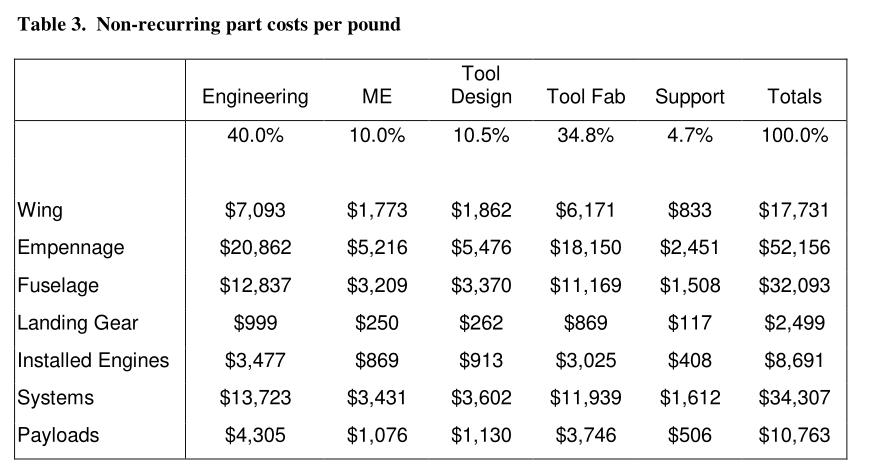A 153-page2002 MIT research (SM thesis) titled Valuation Techniques for Commercial Aircraft Program Design by Jacob Markish[1] arrived at MIT breaks down the valuation of the design of commercial aircrafta correlation between weight and cost based on publicly available figures.
The non-recurring (development) cost of a wing is broken down into engineering, manufacture engineering (ME), tool design, tool fabrication, and support.:
For the wing (and the other parts), it's a dollar value per pound.
- engineering
- manufacture engineering (ME)
- tool design
- tool fabrication
- support
The engineering of a wing (clean slate) costs \$7,093 per pound. The total for the wing is $17\$17,731 (per pound). If it is not a clean slate design,If it is not a clean slate design, say the DC-10 / MD-11 example, then it's 20% of the engineering, 5% of the tool design/fabrication, and 50% of the ME and support.
Applying to MD-11 and MD-90
Engineering ME Tool Design Tool Fab Support Totals 40.0% 10.0% 10.5% 34.8% 4.7% 100.0% Wing \$7,093 \$1,773 \$1,862 \$6,171 \$833 \$17,731 Empennage \$20,862 \$5,216 \$5,476 \$18,150 \$2,451 \$52,156 Fuselage \$12,837 \$3,209 \$3,370 \$11,169 \$1,508 \$32,093 Landing Gear \$999 \$250 \$262 \$869 \$117 \$2,499 Installed Engines \$3,477 \$869 \$913 \$3,025 \$408 \$8,691 Systems \$13,723 \$3,431 \$3,602 \$11,939 \$1,612 \$34,307 Payloads \$4,305 \$1,076 \$1,130 \$3,746 \$506 \$10,763
Seeing how the table belowabove shows how expensive the empennage and systems are, and with the major changes done to those areas on the MD-11, one can see why they went this way.

Note: The thesis arrives at a correlation between weight and cost based on publicly available figures, however it does remain a simplification. Regarding(Regarding a comment about the weight of composites vs. metals: a composite airliner is generally not lighter.)
1: Markish, Jacob. Valuation techniques for commercial aircraft program design. Diss. Massachusetts Institute of Technology, 2002.
